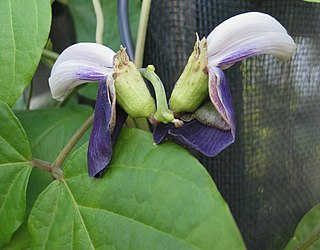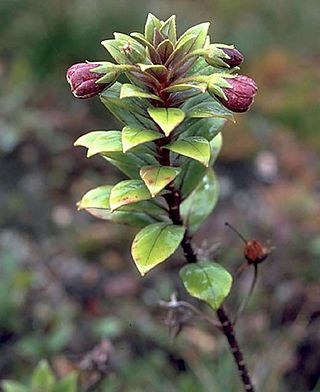
The Alakaʻi Wilderness Preserve, popularly known as Alakaʻi Swamp, is a montane wet forest on the Hawaiian island of Kauaʻi. Although the preserve is home to alpine bogs, it is not a true swamp. It is located on a plateau near Mount Waiʻaleʻale, one of the wettest spots on Earth. Due to its unique combination of high elevation and climate, the Alakaʻi Swamp harbors a large number of endangered endemic species that are only found in this area and whose population has been dramatically declining over the last decades. It is designated as a IUCN protected area.

Canavalia napaliensis, commonly known as the Mākaha Valley Jack-bean, is a species of flowering plant in the pea family, Fabaceae, that is endemic to Hawaii. It was previously more widespread in the archipelago and could be found in Oʻahu's Mākaha Valley, but is today restricted to northwestern Kauaʻi. This and other Hawaiian Canavalia are known there as ʻāwikiwiki.
Geniostoma cyrtandrae, the Koʻolau Range labordia, is a species of flowering plant in the Loganiaceae family. It is endemic to lowland tropical moist forests in Hawaiʻi, and is threatened by habitat loss. Like other labordias, this plant is known as Kamakahala.
Geniostoma kaalae, the Waianae Range labordia, is a species of flowering plant in the Loganiaceae family.
Melicope haupuensis is a species of tree in the family Rutaceae known by the common names Haupa Mountain melicope and Pacific pelea. It is endemic to the Hawaiian Islands, where it is known only from the island of Kauai. It is threatened by habitat loss. It is a federally listed endangered species of the United States. Like other Hawaiian Melicope, this species is known as alani.
Myrsine knudsenii, the Kokee colicwood, is a species of tree in the primrose family. It is endemic to the island of Kauai in Hawaii. It is threatened by habitat loss.
Myrsine mezii, the Hanapepe River colicwood, is a species of tree in the primrose family. It is endemic to the island of Kauai in Hawaii. It is threatened by habitat loss. It is a federally listed endangered species of the United States.

Pittosporum napaliense, the royal cheesewood, is a species of plant in the Pittosporaceae family. It is endemic to Hawaii, where it is known only from northwestern Kauai. It became a federally listed endangered species in 2010.
Psychotria grandiflora, the largeflower wild coffee, large-flowered balsamo or kopiko, is a species of plant in the family Rubiaceae endemic to the island of Kauai in the Hawaiian Islands. It grows in rainforest habitat. There are ten small populations remaining, with a total of no more than 30 individuals. This plant was federally listed as an endangered species of the United States in 2010.
Psychotria hobdyi, the milolii kopiwai, Hobdy's wild-coffee or kopiko, is a species of plant in the family Rubiaceae. It is endemic to the Hawaiian Islands, where it is known only from the island of Kauai. There are about 10 populations for a total of about 120 individuals. It is threatened by habitat loss and was federally listed as an endangered species of the United States in 2010.
Cyanea eleeleensis was a rare species of flowering plant in the bellflower family known by the common name Eleele cyanea. It was endemic to Kauai, where it has been declared extinct. It was federally listed as a critically endangered species of the United States in 2010. Like other Cyanea it is known as haha in Hawaiian.

Delissea rhytidosperma, is known by the common names Kauai delissea, Kauai leechleaf delissea, and leechleaf delissea. It is a rare species of flowering plant in the bellflower family, that is endemic to Hawaii where it is known only from the island of Kauai. It is critically endangered or extinct in the wild.
Dubautia kenwoodii, the Kalalau rim dubautia, is an "extremely rare" species of flowering plant in the family Asteraceae. It is endemic to Hawaii where it is known only from the island of Kauai. Only one plant has ever been seen: the type specimen. A part of this plant was collected in 1991 and the individual was described as a new species in 1998. It was federally listed as an endangered species of the United States in 2010. Like other Dubautia this plant is known as naʻenaʻe.
Geranium kauaiense is a rare species of geranium known by the common name Kauai geranium. It is endemic to Hawaii, where it is known only from the island of Kauai. It was federally listed as an endangered species in 2010. Like other Hawaiian geraniums, this plant is known as hinahina and nohoanu.

Gouania meyenii is a rare species of flowering plant known by the common name smoothfruit chewstick or Meyen's gouania. It is endemic to Hawaii, where it is known only from Oahu and Kauai. It is estimated that there are between 38 and 63 individuals of this species remaining in the wild. It is a federally listed endangered species of the United States.
Geniostoma helleri, the Nā Pali coast labordia or Heller's labordia, is a rare species of flowering plant in the Loganiaceae family. It is endemic to Hawaii, where it is found only on Kauai. It is a federally listed endangered species of the United States. Like other labordias, this plant is known as Kamakahala.

Lysimachia daphnoides is a rare species of flowering plant in the Primulaceae known by several common names, including Pacific loosestrife, lehua makanoe, kolekole lehua, and kolokolo kuahiwi. It is endemic to Hawaii, where there are only three populations remaining on the island of Kauai. It was federally listed as an endangered species of the United States in 2010.
Poa mannii is a rare species of grass known by the common names Mann's bluegrass and Olokele Gulch bluegrass. It is endemic to Hawaii, where it is limited to the island of Kauai. It is threatened by the loss and modification of its habitat. It is a federally listed endangered species of the United States.
Schiedea attenuata is a rare species of flowering plant in the family Caryophyllaceae known by the common name Kalalau schiedea. It is endemic to Hawaii, where it is known only from the Kalalau Valley on the island of Kauai. It is threatened by the degradation of its habitat. It was federally listed as an endangered species of the United States in 2010.
Schiedea helleri is a rare species of flowering plant in the family Caryophyllaceae known by the common names Heller's schiedea and Kaholuamanu schiedea. It is endemic to Hawaii, where it is known only from the island of Kauai. It is threatened by the degradation of its habitat. It was federally listed as an endangered species of the United States in 1996.







